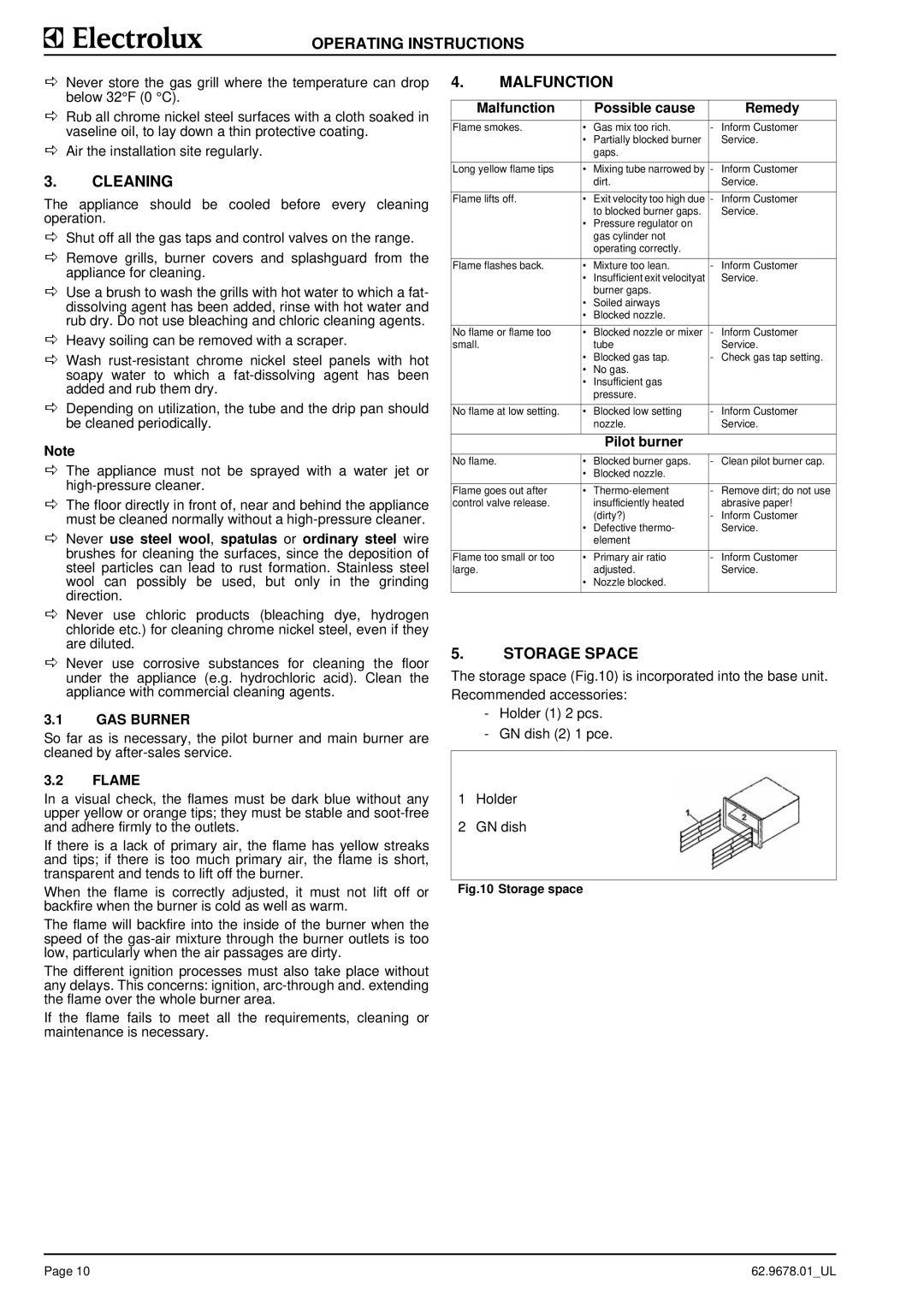
OPERATING INSTRUCTIONS
DNever store the gas grill where the temperature can drop below 32°F (0 °C).
DRub all chrome nickel steel surfaces with a cloth soaked in vaseline oil, to lay down a thin protective coating.
DAir the installation site regularly.
3.CLEANING
The appliance should be cooled before every cleaning operation.
DShut off all the gas taps and control valves on the range.
DRemove grills, burner covers and splashguard from the appliance for cleaning.
DUse a brush to wash the grills with hot water to which a fat- dissolving agent has been added, rinse with hot water and rub dry. Do not use bleaching and chloric cleaning agents.
DHeavy soiling can be removed with a scraper.
DWash
DDepending on utilization, the tube and the drip pan should be cleaned periodically.
Note
DThe appliance must not be sprayed with a water jet or
DThe floor directly in front of, near and behind the appliance must be cleaned normally without a
DNever use steel wool, spatulas or ordinary steel wire brushes for cleaning the surfaces, since the deposition of steel particles can lead to rust formation. Stainless steel wool can possibly be used, but only in the grinding direction.
4.MALFUNCTION
Malfunction |
| Possible cause |
| Remedy |
Flame smokes. | • | Gas mix too rich. | - | Inform Customer |
| • | Partially blocked burner |
| Service. |
|
| gaps. |
|
|
|
|
|
|
|
Long yellow flame tips | • | Mixing tube narrowed by | - | Inform Customer |
|
| dirt. |
| Service. |
|
|
|
|
|
Flame lifts off. | • | Exit velocity too high due | - | Inform Customer |
|
| to blocked burner gaps. |
| Service. |
| • | Pressure regulator on |
|
|
|
| gas cylinder not |
|
|
|
| operating correctly. |
|
|
|
|
|
|
|
Flame flashes back. | • | Mixture too lean. | - | Inform Customer |
| • | Insufficient exit velocityat |
| Service. |
|
| burner gaps. |
|
|
| • | Soiled airways |
|
|
| • | Blocked nozzle. |
|
|
|
|
|
|
|
No flame or flame too | • | Blocked nozzle or mixer | - | Inform Customer |
small. |
| tube |
| Service. |
| • | Blocked gas tap. | - | Check gas tap setting. |
| • | No gas. |
|
|
| • | Insufficient gas |
|
|
|
| pressure. |
|
|
|
|
|
|
|
No flame at low setting. | • | Blocked low setting | - | Inform Customer |
|
| nozzle. |
| Service. |
|
|
|
|
|
|
| Pilot burner |
|
|
No flame. | • | Blocked burner gaps. | - | Clean pilot burner cap. |
| • | Blocked nozzle. |
|
|
|
|
|
|
|
Flame goes out after | • | - | Remove dirt; do not use | |
control valve release. |
| insufficiently heated |
| abrasive paper! |
|
| (dirty?) | - | Inform Customer |
| • | Defective thermo- |
| Service. |
|
| element |
|
|
|
|
|
|
|
Flame too small or too | • | Primary air ratio | - | Inform Customer |
large. |
| adjusted. |
| Service. |
| • | Nozzle blocked. |
|
|
|
|
|
|
|
DNever use chloric products (bleaching dye, hydrogen chloride etc.) for cleaning chrome nickel steel, even if they are diluted.
DNever use corrosive substances for cleaning the floor under the appliance (e.g. hydrochloric acid). Clean the appliance with commercial cleaning agents.
3.1GAS BURNER
So far as is necessary, the pilot burner and main burner are cleaned by
3.2FLAME
In a visual check, the flames must be dark blue without any upper yellow or orange tips; they must be stable and
If there is a lack of primary air, the flame has yellow streaks and tips; if there is too much primary air, the flame is short, transparent and tends to lift off the burner.
When the flame is correctly adjusted, it must not lift off or backfire when the burner is cold as well as warm.
The flame will backfire into the inside of the burner when the speed of the
The different ignition processes must also take place without any delays. This concerns: ignition,
If the flame fails to meet all the requirements, cleaning or maintenance is necessary.
5.STORAGE SPACE
The storage space (Fig.10) is incorporated into the base unit. Recommended accessories:
-Holder (1) 2 pcs.
-GN dish (2) 1 pce.
1Holder
2GN dish
Fig.10 Storage space
Page 10 | 62.9678.01_UL |
